Fonthill Castle located in Doylestown, Pennsylvania is built completely of concrete and tiles by one
Henry Chapman Mercer (1856-1930) between the years of 1908-1912. That was the destination of a journey Ruth of
Illegal Protest took me on last week to celebrate my birthday while I was still in the Philadelphia area.
Henry Mercer started with a wooden farmhouse and then coated it in concrete and then kept expanding the building pouring more and more to finally end up with the castle you see in the pictures. We took a tour of the building and the unfortunate part is that while I was attempting to take my first interior shot, I was quickly rebuffed by a kind of nasty older woman at the registration desk shouting "no pictures are allowed inside of the building". Therefore I have little to show you in the way of the interior of Fonthill castle.
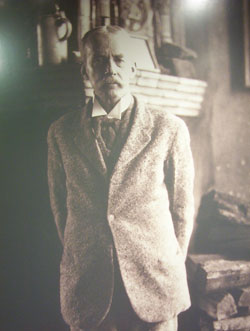
Henry Mercer |
An older gentleman by the name of Ken took us through and showed us everything from intricate tiling to original art and books and also fascinating artifacts that were built into the walls like real Sumerian Cuneiform tablets circa 2500 BC. Both Ruth and myself enjoyed ourselves and had a good time being the intellectual geeks that we are. The inside of Fonthill Castle was hotter than hell though and I could feel the sweat rolling down my spine a few times.
Mercer really was a fascinating guy having acquired a traditional education at Harvard and obtaining a law degree only to go on to best be remembered for his self-taught artistic, archaeological and architect side than anything he could have probably ever accomplished with his law degree. I saw a lot of myself in Henry Mercer and relished in his eccentric tastes and life that he had. He can only be described as a true renaissance man.
(Many more pics and some video below)
The yard at Fonthill Castle is quite large and extraordinary with paths that go over small concrete bridges, streams and ponds that flow bringing a nice tranquil setting to the place. There also were paths through the bright green woods that were nice and inviting, though I would assume they were quite creepy at night.
Here's a few more pictures of the forest and then some on the Mercer Museum, which is a separately located building that was also built by Henry Mercer and is stocked with tools from through the ages and some interesting artifacts.
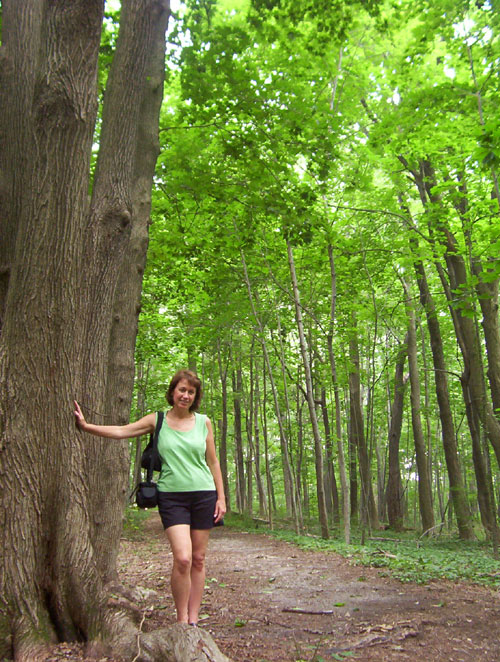
Ruth poses in the enchanted forest |
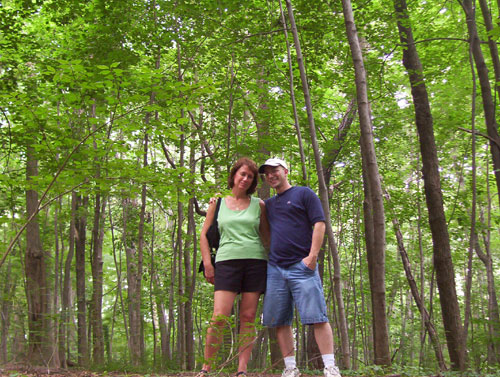
Digger Gives Ruth A Squeeze While Deep In The Forest |
Ever wonder what putting these posts together entails? Watch the video below as Ruth documents me as I walk around taking a bunch of pictures and acting goofy. There are also some great shots of Fonthill that pictures just don't do justice, such as the true scale of the building. Also included are some portions of the Mercer Museum.
Mercer Museum
The Mercer Museum is a collection of past tools and artifacts. Inside was everything from tools used for blacksmithing to textiles and wood working. In general I found the museum to be interesting in some portions, but simply dull in others. It was also hotter than hell inside as you can see me attest to in the video above. Unlike Fonthill Castle, photographs were allowed in the museum.
Below are things that I found interesting, such as the tools of crime and the vampire killing kit. Others may find some of the other tools interesting, but both Ruth and I had just about had enough of all the walking and the heat halfway through the museum. Tools can only be interesting for so long and there are literally thousands upon thousands in there. If you do have an interest in the history of the tools used in the past for certain things then this is the place for you. We both also found that it was surprising how some tools used in the past are virtually the same as those used today.
(Description of above items)
1. Hatchet (c. 1890) Weapon used by Wallace Burt to murder Samuel and Lena Rightly of Northampton Township in 1893. Believing that the Rightlys had underpaid him for some farm work, a drunken Burt killed the couple in their sleep and then set their home on fire. After finally confessing, he was hanged for his crime in 1894.
2. Flintlock Pistol (c. 1750 Bumford, London, England) Purportedly left behind by robbers who invaded, then fled, the home of Jacob Miller of New Britain, Bucks County in 1893.
3. Blackjack (19th Century) A bludgeon-type weapon, sometimes used in street fighting or strong-arm robberies.
4. Flintlock Musket (c. 1770-1780) Alleged to have belonged to Abraham Doan, member of an outlaw band that terrorized Bucks County and southeastern Pennsylvania during the Revolutionary War era. Doan is supposed to have dropped the gun while escaping from a posse that killed his brother in 1783.
5. Hacksaw Blades (19th Century) Allegedly used by Alfred Teufel to saw off his leg irons while confined and awaiting trial for murder in the Bucks County Jail in Doylestown. The blades had been concealed in a bible sent to him from Philadelphia. Failing to escape, Teufel was later convicted in the killing of James Wiley, a canal boat captain, in Nickamixon Township. The twenty-two year old Teufel was hanged in 1867.
6. Handcuffs (c. 1863-1890)
7. Manacles (c.1800-1850)
8. Manacles (c. 1820-1860)
9. "Come-Alongs" (c. 1850-1900) Used by Captain Thomas Brown of the Philadelphia Police Department. Wound around a suspect's wrists, these simple handcuffs allowed an officer to control and lead a prisoner.
10. Manacles (c. 1820-1870)
11. Constable's Club (19th Century)
(description of above items)
1. Hangman's Noose (20th Century) Made as a demonstration piece by an executioner for the state of Washington. Never used.
2. Leg Shackles (19th Century)
3. Leg Shackles (19th Century) From the old Bucks County Jail on Court Street in Doylestown. Built in 1813, it was torn down in 1885 following construction of a new prison on Pine Street.
4. Shackle Chain (c. 1830) Supposedly used in the county prison to confine Lino de Mina convicted of murdering Dr. William Chapman of Andulusia, Bucks County. Mina was alleged to have conspired with Chapman's wife Lucretia, in poisoning her husband. Though Lucretia was acquitted, the court sentenced Mina to hang in 1832. The order was carried out before a large crowd of onlookers in the last public execution of Bucks County.
5. Shackle Chain (c. 1865) Purportedly used to restrain Albert Teufel, convicted killer of canal boat captain James Wiley, in 1867. The powerfully built Teufel was notorious for his ability to break out of handcuffs, shackles and other light restraints.
6. Leg Shackles (c. 1860-1870) Worn by an inmate of the Bucks County Jail in the 1870's. He escaped and freed himself from the shackles using a chisel "borrowed" from a local farm.
7. Wrist Shackles (Early 19th Century)
8. Toy Ox Yoke (c. 1900) Such crafts helped prisoners pass time during their confinement.
9. Wrist Shackles (19th Century)
10. Mouth Gag (Early 19th Century) Purchased by Mercer at a Philadelphia antiques shop, his cataloging notes state that the gag was used "to prevent the outcry of a victim under punishment or torture".
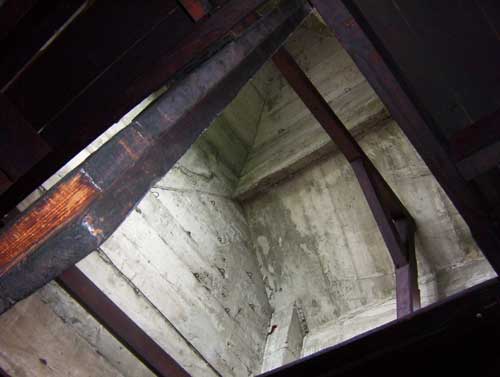
The Gallows As Seen Through The Trap Door At The Mercer Museum |
The Mercer Museum is 6 floors and was also built by Henry Mercer using the same concrete method used at Fonthill Castle.
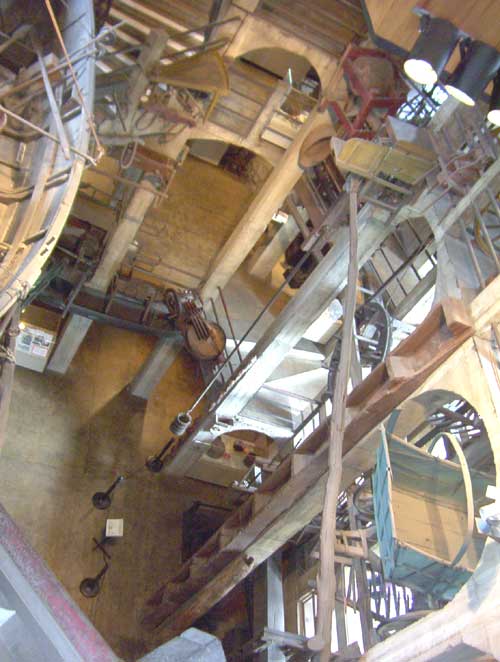
A dizzy view from the 6th floor of the Mercer Museum |
Little glass enclosed rooms, like that pictured below, fill the museum. Each room as a written plaque with information, but apparently they have headphones with different channels as well that give even more information. We didn't find that out until Ruth noticed it later. I shot this picture through the glass and it depicts the tools of a tailor.
There were other artifacts in the museum as well other than tools such as the chairs and other items that appear to be floating in mid air from the ceiling of the museum.
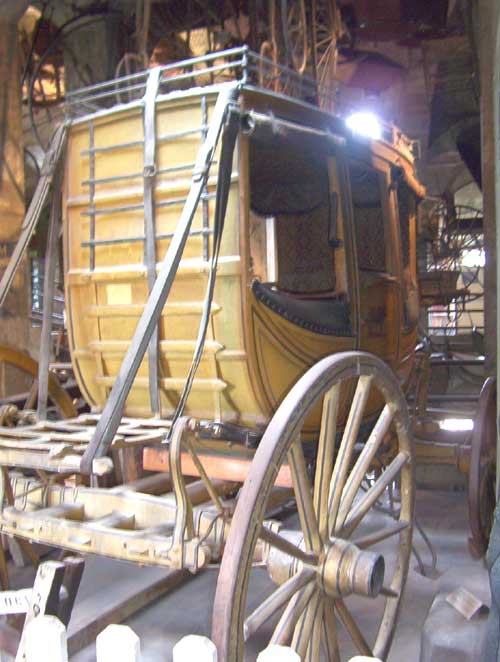
A full size carriage at the Mercer Museum |
Some tools used for hunting are pictured below.
The key to the front door of Fonthill Castle has also been preserved. This key is giant and would fit firmly in my palm.
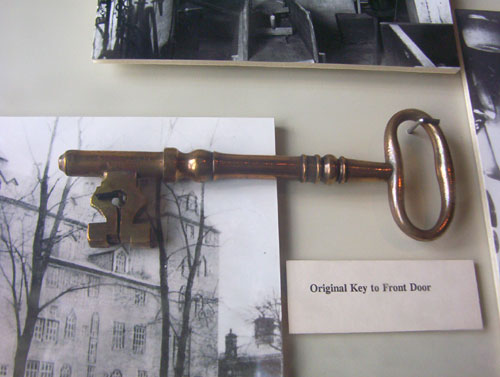
The front door key to Fonthill Castle |
There were also many weird and strange cigar store statues like the one below. Some would be considered racist today.
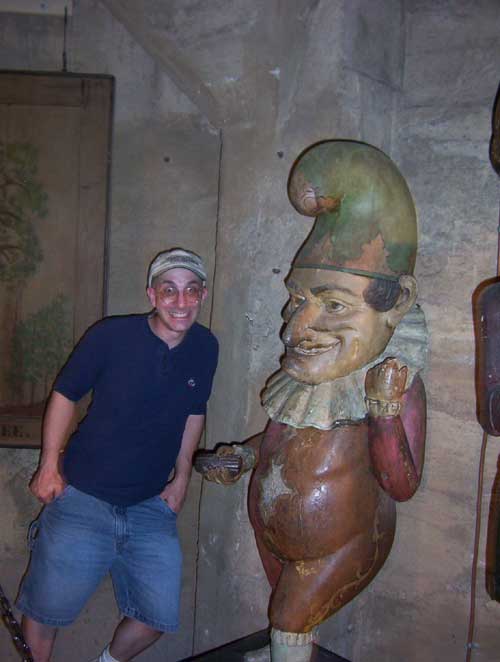
Digger doing his best impression of a cigar store statue |
The most odd and interesting of all items in the museum, in my opinion, was the Vampire Killing Kit
Seen below are the kit itself, a blown up image of the cases writings and some information on whether the kit is real or not.
The most incredible of all the items in the museum are those below. A civil war painting and an actual civil war battle flag from the Ringgold Regiment, 104th Pennsylvania volunteer infantry. Imagine what this flag has seen.
And with that I'll end this little journey through the Fonthill Castle and Mercer Museum. If you ever find yourself in Doylestown, Pennsylvania look it up.
Don't forget to visit Ruth's site over at Illegal Protest
You can find out more about Fonthill and the Mercer Museum at the Bucks County Historical Society website for the Mercer Museum

